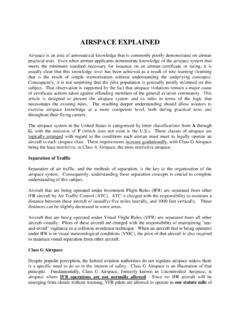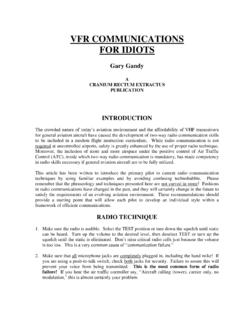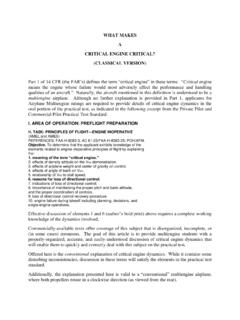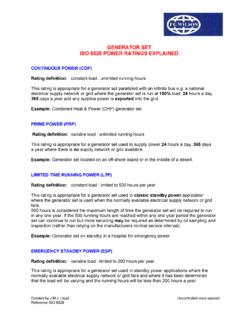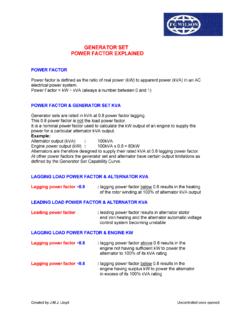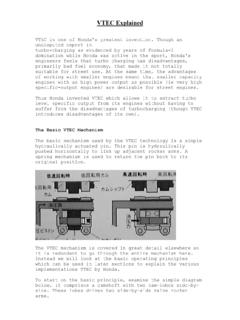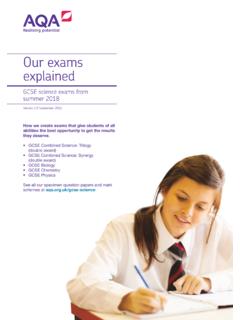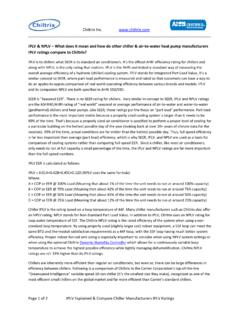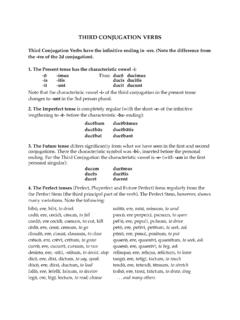Transcription of AIRSPACE EXPLAINED - West Wings Inc
1 AIRSPACE EXPLAINED AIRSPACE is an area of aeronautical knowledge that is commonly poorly demonstrated on airman practical tests. Even when airman applicants demonstrate knowledge of the AIRSPACE system that meets the minimum standard necessary for issuance on an airman certificate or rating, it is usually clear that this knowledge level has been achieved as a result of rote learning (learning that is the result of simple memorization without understanding the underlying concepts). Consequently, it is not surprising that the pilot population is generally poorly informed on this subject.
2 That observation is supported by the fact that AIRSPACE violations remain a major cause of certificate actions taken against offending members of the general aviation community. This article is designed to present the AIRSPACE system and its rules in terms of the logic that necessitates the existing rules. The resulting deeper understanding should allow aviators to exercise AIRSPACE knowledge at a more competent level, both during practical tests and throughout their flying careers. The AIRSPACE system in the United States is categorized by letter classifications from A through G, with the omission of F (which does not exist in the ).
3 These classes of AIRSPACE are logically arranged with regard to the conditions each airman must meet to legally operate an aircraft in each AIRSPACE class. These requirements increase gradationally, with Class G AIRSPACE being the least restrictive, to Class A AIRSPACE , the most restrictive AIRSPACE . Separation of Traffic Separation of air traffic, and the methods of separation, is the key to the organization of the AIRSPACE system. Consequently, understanding these separation concepts is crucial to complete understanding of this subject.
4 Aircraft that are being operated under Instrument Flight Rules (IFR) are separated from other IFR aircraft by Air Traffic Control (ATC). ATC is charged with the responsibility to maintain a distance between these aircraft of (usually) five miles laterally, and 1000 feet vertically. These distances can be slightly decreased in some areas. Aircraft that are being operated under Visual Flight Rules (VFR) are separated from all other aircraft visually. Pilots of these aircraft are charged with the responsibility of maintaining see-and-avoid vigilance as a collision avoidance technique.
5 When an aircraft that is being operated under IFR is in visual meteorological conditions (VMC), the pilot of that aircraft is also required to maintain visual separation from other aircraft. Class G AIRSPACE Despite popular perception, the federal aviation authorities do not regulate AIRSPACE unless there is a specific need to do so in the interest of safety. Class G AIRSPACE is an illustration of that principle. Fundamentally, Class G AIRSPACE , formerly known as Uncontrolled AIRSPACE , is AIRSPACE where IFR operations are not normally allowed.
6 Since no IFR aircraft will be emerging from clouds without warning, VFR pilots are allowed to operate in one statute mile of visibility and are required to remain simply clear of clouds during daylight hours. The wisdom of operating visually in these conditions is questionable, so the weather minimums for night operations in Class G AIRSPACE have been increased to 3 statute miles of visibility with cloud clearances of 500 feet below, 1000 feet above, and 2000 feet horizontally. Originally, IFR was mostly confined to airlines and corporate aircraft, and IFR approaches were conducted only at the largest airports.
7 The cost of equipment required for IFR flight was beyond the financial capabilities of the operators of most general aviation aircraft. Very few smaller airports had instrument approaches available. Under these conditions, Class G AIRSPACE , originally called Uncontrolled AIRSPACE , was the most common type of AIRSPACE . But in the past 30 years, the affordability of instrument equipment, both for aircraft and for airports, has led to a massive expansion of IFR operations. Consequently, Class G AIRSPACE has shrunk dramatically.
8 In most places in the United States, it is now only found underlying Class E AIRSPACE (See Figure 1). 12345aALTITUDE ENCODING REQUIREDNO SPEED LIMITSPEED LIMIT: 250 KT1 MILE VISIBILITYCLEAR OF CLOUDS(DAYLIGHT HOURS)CLASS GCLASS ECLASS ECEILING 1000 CLASS E10,000 MSLT ransitionZone3 miles5 miles1 mile700 1,200 1000 1000 1000 500 2000 Flight Level 18018,000 Pressure AltitudeCLASS A (POSITIVE CONTROL) AIRSPACEIFR ONLY!614,500 Figure 1 The aircraft on the left is executing an instrument approach to the airport at the center of the diagram.
9 The instrument approach is designed to get the IFR aircraft close enough to the airport for the pilot to establish visual contact and land. The approach begins in Class E AIRSPACE at an altitude above 1,200 feet AGL. Closer to the airport, the IFR aircraft requires a step-down to get within sight of the field. In this Transition Zone, the base of Class E AIRSPACE is lowered to 700 feet AGL. Since the AIRSPACE system is designed to keep IFR aircraft from operating in Class G AIRSPACE , are allowed to operate in areas marked 4 and 5 while remaining clear of clouds in visibilities as low as one statute mile during daylight hours.
10 Pilots operating under VFR in Class G AIRSPACE after dark are required to remain 500 feet below clouds, 1000 feet above clouds, and 2000 feet horizontally from clouds while maintaining an inflight visibility of three statute miles. On the sectional aeronautical chart, Class G AIRSPACE is depicted as shown on Figure 2. 453 Figure 2 The magenta shaded area (4) represents the Transition Zone and encloses an area in which Class G AIRSPACE extends from the surface up to 700 feet AGL. (Note that transitions zones may contain extensions to accommodate the requirements of instrument approach procedures.)
